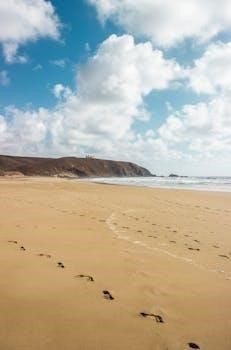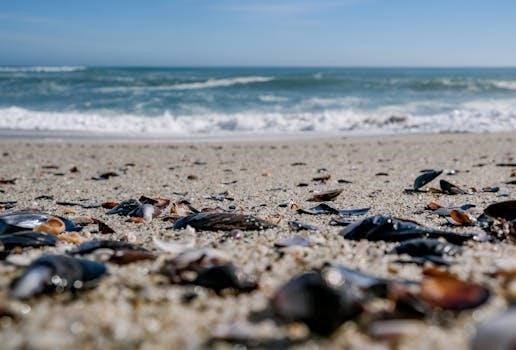cape to cape walk map pdf
Cape to Cape Walk Map PDF⁚ A Comprehensive Guide
Embark on an unforgettable journey with a comprehensive guide featuring Cape to Cape Walk maps in PDF format. These resources are essential for navigating the stunning Western Australian coastline.
The Cape to Cape Track‚ a jewel of Western Australia‚ offers a breathtaking 123-kilometer hiking experience along the Leeuwin-Naturaliste Ridge. Stretching between the iconic lighthouses of Cape Naturaliste and Cape Leeuwin‚ this trail presents a diverse landscape of coastal cliffs‚ pristine beaches‚ and lush forests. As you traverse this remarkable path‚ you’ll encounter unique flora and fauna‚ making it a haven for nature enthusiasts.
This track‚ located in the Margaret River region‚ is more than just a hike; it’s an immersion into the natural beauty and rich biodiversity of the area. It’s an opportunity to challenge yourself physically while connecting with the environment. Whether you’re a seasoned hiker or a nature lover seeking adventure‚ the Cape to Cape Track promises an unforgettable experience. Prepare to be captivated by the stunning vistas and the raw‚ untamed beauty of this extraordinary trail.

Overview of the Cape to Cape Track
The Cape to Cape Track‚ a 123-kilometer trail in Western Australia‚ offers hikers stunning coastal views and diverse landscapes. This challenging yet rewarding hike typically takes several days to complete.
Location and Length of the Track
The Cape to Cape Track is located in the southwest corner of Western Australia‚ nestled within the Leeuwin-Naturaliste National Park. This spectacular trail stretches for approximately 123 kilometers (or about 76 miles)‚ traversing the entire length of the Leeuwin-Naturaliste Ridge. It meanders along the coast‚ offering breathtaking views of the Indian Ocean and the region’s unique flora and fauna.
The track runs between the iconic lighthouses of Cape Naturaliste in the north and Cape Leeuwin in the south. This positioning makes it a prominent feature of the capes region‚ near Margaret River. The precise position of the track can be viewed on the maps. Hikers typically require between 5 to 7 days to complete the entire length‚ depending on their fitness level and chosen pace. The availability of detailed maps ensures hikers stay on course.
Cape Naturaliste to Cape Leeuwin Lighthouses
The Cape to Cape Track derives its name and significance from the two iconic lighthouses that mark its endpoints⁚ Cape Naturaliste Lighthouse and Cape Leeuwin Lighthouse. Cape Naturaliste Lighthouse stands at the northern end‚ offering panoramic views of Geographe Bay and the surrounding coastline. It serves as a starting point for many hikers;
At the southern end of the track‚ Cape Leeuwin Lighthouse marks the meeting point of the Indian and Southern Oceans. This historic lighthouse offers tours and insights into the maritime history of the region. These two lighthouses are not only navigational aids but also cultural landmarks. They symbolize the beginning and end of a remarkable journey. Traversing the path between the two offers stunning cliff-top views.

Maps and Navigation Resources
Navigating the Cape to Cape Track requires reliable maps and resources. These tools ensure safety and enhance the overall hiking experience‚ providing essential information about the trail’s terrain and points of interest.
Importance of Maps for the Cape to Cape Walk
Maps are undeniably critical for a successful and safe Cape to Cape Walk. This 123-kilometer (or 135-kilometer‚ depending on source) trek demands careful planning and execution‚ and maps serve as the foundation for informed decision-making. They provide essential topographical details‚ indicating elevation changes‚ water sources‚ and potential hazards along the Leeuwin-Naturaliste Ridge.
Detailed maps enable hikers to accurately gauge distances between landmarks and waypoints‚ aiding in time management and preventing unexpected delays. Furthermore‚ maps highlight important features such as access roads‚ paths‚ and points of interest within the Leeuwin-Naturaliste National Park. In emergency situations‚ maps become invaluable tools for navigation and communication with rescue services.
Whether using traditional paper maps or digital versions‚ carrying reliable maps is non-negotiable for anyone undertaking the Cape to Cape Walk. They are not just helpful; they are a necessity.
Availability of PDF Maps and Track Guides
Fortunately‚ a wealth of resources is available to assist hikers in planning and executing their Cape to Cape Walk. PDF maps and track guides are readily accessible‚ offering detailed information and navigational support. Several organizations and publishers provide comprehensive maps covering the entire track‚ from Cape Naturaliste to Cape Leeuwin.
These PDF maps often include essential details such as contour lines‚ landmarks‚ water sources‚ and campsites. Track guides complement the maps by providing detailed descriptions of each section of the trail‚ including difficulty levels‚ points of interest‚ and safety tips. Many of these resources are designed to be easily downloaded and printed‚ allowing hikers to carry physical copies on their trek.
Furthermore‚ some websites offer interactive maps and downloadable KMZ files for use with GPS devices and smartphone apps. Whether you prefer traditional paper maps or digital navigation‚ ample resources exist to ensure you are well-equipped for the Cape to Cape Walk.
Digital Map Resources (KMZ Files)
For tech-savvy hikers‚ digital map resources‚ particularly KMZ files‚ offer a convenient and interactive way to navigate the Cape to Cape Track. KMZ files are essentially compressed versions of KML (Keyhole Markup Language) files‚ which can be opened in various mapping applications like Google Earth‚ Garmin BaseCamp‚ and smartphone apps with GPS capabilities.
These files typically contain detailed track information‚ including waypoints‚ points of interest‚ and elevation profiles. Hikers can load KMZ files onto their devices to view the track overlaid on satellite imagery or topographic maps. This allows for real-time tracking of their location and progress along the trail.
The Department of Biodiversity‚ Conservation and Attractions (DBCA) may provide KMZ files for the Cape to Cape Walk Track. These files are invaluable for planning and navigating the trail‚ especially in areas with limited or no mobile reception. Ensure your chosen app supports KMZ files before your hike!
Track Details and Logistics
Understanding the track’s details and logistical considerations is crucial for a successful Cape to Cape Walk. This section provides essential information regarding distance‚ duration‚ difficulty‚ and necessary skills for the journey.
Track Distance and Duration
The Cape to Cape Walk Track stretches approximately 123 to 135 kilometers (76 to 84 miles) along the captivating Leeuwin-Naturaliste Ridge. This iconic trail‚ nestled in the southwest corner of Western Australia‚ offers a diverse landscape of coastal cliffs‚ pristine beaches‚ and lush forests. The track typically takes between 5 to 8 days to complete‚ depending on fitness levels‚ chosen itinerary‚ and desired pace.
Hikers should carefully consider their daily distances‚ planning for an average of 15 to 25 kilometers per day. Several access points along the track allow for shorter sections to be undertaken. Proper planning and the use of detailed maps are essential for estimating travel times between landmarks and campsites. Factors such as terrain‚ weather conditions‚ and rest stops will influence the actual duration of each day’s walk. Be sure to consult updated resources for the most accurate information to ensure a safe and enjoyable hiking experience.
Difficulty Level and Required Skills
The Cape to Cape Track is generally considered a moderately challenging hike‚ requiring a reasonable level of fitness and some bushwalking experience. The terrain varies‚ with some sections involving steep ascents and descents‚ rocky paths‚ and sandy stretches. Navigation skills are crucial‚ especially in areas with limited signage.
Essential skills include map reading‚ compass use‚ and the ability to interpret track notes. Participants should also possess basic first aid knowledge and be prepared to handle minor injuries. Emergency preparedness is paramount; carrying a personal locator beacon (PLB) or satellite communication device is highly recommended. Good physical conditioning is vital‚ as hikers will be carrying backpacks for multiple days. Prior experience with multi-day hikes is beneficial‚ as is the ability to adapt to changing weather conditions. Overall‚ a combination of fitness‚ navigation skills‚ and preparedness will ensure a safe and enjoyable experience on the Cape to Cape Track.

Planning Your Cape to Cape Walk
Careful planning is essential for a successful Cape to Cape walk. Consider transportation‚ accommodation‚ and necessary permits. Research the track conditions‚ pack appropriately‚ and ensure you have sufficient water and supplies for a safe and enjoyable trek.
Transportation and Car Parking
Arranging transportation to and from the Cape to Cape Track is a crucial part of your planning. The track begins at Cape Naturaliste and concludes at Cape Leeuwin‚ requiring logistical considerations for reaching the starting point and departing from the finish. Car parking is available at Cape Naturaliste in the national park’s public access carpark‚ offering a convenient option for those driving themselves. However‚ if you intend to hike the entire track‚ you’ll need to arrange transportation back to your vehicle or onward to your next destination.
Charter transport services are available from private operators‚ offering tailored solutions for hikers. These services can provide pick-up and drop-off at various points along the track‚ as well as airport transfers. Check the Transport Services page on relevant websites for a list of reputable operators. Public transport options are limited in this region‚ making private transport or shuttle services the most reliable choices. Careful planning of your transportation will ensure a smooth and stress-free Cape to Cape experience.
Accommodation Options Along the Track
When planning your Cape to Cape adventure‚ considering accommodation options is paramount. Along the track‚ you’ll find a range of choices to suit various budgets and preferences. Camping is a popular option‚ allowing you to immerse yourself in the natural beauty of the Leeuwin-Naturaliste National Park. Designated campsites are available‚ but it’s essential to book in advance‚ especially during peak season.
For those seeking more comfort‚ coastal villas and apartments offer a luxurious alternative. These options provide amenities such as private bathrooms‚ fully equipped kitchens‚ and comfortable living spaces. Many are located in towns close to the track‚ allowing for easy access. Hostels‚ hotels‚ and bed and breakfasts can also be found in nearby towns‚ offering a mix of affordability and convenience. Researching and booking your accommodation well in advance is highly recommended to secure your preferred lodging and ensure a relaxing and enjoyable hike.

Points of Interest and Features
The Cape to Cape Track is rich with diverse attractions. Discover stunning coastal views‚ unique flora and fauna‚ and historical landmarks. This walk offers an immersive experience in nature’s beauty.
Leeuwin-Naturaliste National Park
The Leeuwin-Naturaliste National Park forms the backbone of the Cape to Cape Track‚ showcasing the region’s spectacular natural beauty. The track meanders along the Leeuwin-Naturaliste Ridge‚ offering breathtaking views of sweeping cliff-tops and pristine beaches. This park is a haven for unique plants and animals‚ providing an immersive experience in Western Australia’s diverse ecosystem.
Within the park‚ walkers can explore various terrains‚ from coastal heathlands to forests. The park is also adjacent to the Ngari Capes Marine Park‚ enriching the scenic views. With updated editions of maps and guides‚ navigating through this national park is made easier‚ ensuring an unforgettable adventure. The park contains access roads and paths.
The park offers many circuit walks close to the track for those seeking shorter excursions.
